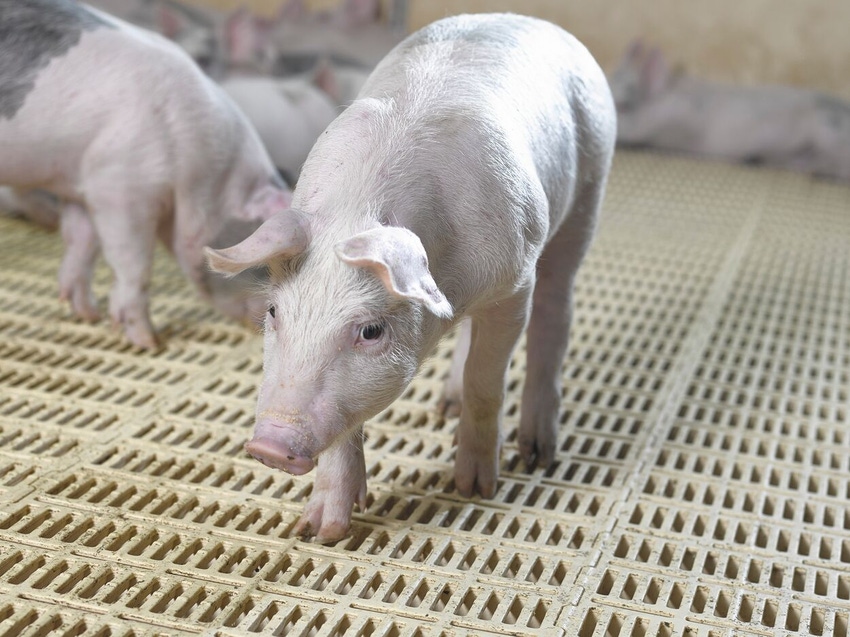Iowa State researchers examine anti-parasitic in sow farms that broke with PRRSV 1-4-4 V1C.

After a recent trial demonstrated that ivermectin treatment inhibits porcine reproductive and respiratory syndrome virus infection in PAM-pCD163 cells in a dose dependent manner in early stages of infection, researchers at Iowa State University set out to see if a standardized dose would have the same impact in a natural infection model.
According to Chris Rademacher, clinical professor in veterinary diagnostic and production animal medicine and swine extension veterinarian at Iowa State University, the study aimed to compare the performance of pens of nursery pigs with different interventions — tulathromycin (Draxxin), ivermectin and control — after a sow farm PRRS outbreak.
"That was the primary objective looking at mortality removal rates and treatment rates. Secondarily, we wanted to take a subset of those pigs and measure PRRS viremia by doing quantitative PCR and infection rates during those treatments," Rademacher says.
The study took place at a site with two sow farms (approximately 4,000 each) that flowed together into a 9,000 head nursery. Both broke with PRRSV 1-4-4 V1C in early 2021.
Each room was only filled by one sow farm. Farm 1 was filled with five rooms and Farm 2 was filled with four rooms. Rooms were filled in one to two wean days, usually two to three days apart. The test included 360 pens.
"Most of the pigs went into general population (63%). They left some empty pens in the middle with pull pens (22%) and then 15% of those pens were left empty and all the small pigs were sorted down upon placement," Rademacher says. "They were all then designated, blocked by type, and strategically allocated into the three study groups by spatial distribution before the beginning of the study using a random sequence generator."
The three treatments were control, tulathromycin at 14 days post weaning and ivermectin at weaning and 14 days post weaning.
"After talking with Dr. Grant Allison, who had done some preliminary work with Ivermectin, we went a little bit higher than traditional labeled anthelmintic dose (0.45 mg/kg SQ/IM) to give us comparable tissue concentrations to what was reported in the paper. All the pigs received Draxxin at weaning PRRS vaccine at weaning time," Rademacher says. "The Draxxin group got a second dose at 14 days and then the ivermectin group got a dose at weaning then again at 14 days."
One pig per pen was then selected at placement and were tagged, weighed and bled. There were 93 pigs per treatment, so 279 total. Those treatments were bled at placement, day 14 and day 28. A Q-PCR test was conducted at all three time points as well as the weighing of pigs to measure the amount of virus in the pigs and see if there was any correlation to growth.
Rademacher says the research team saw no statistical difference between any of the groups from a mortality standpoint (3.6% control, 3.54% tulathromycin, 4.32% ivermectin). For removal rate, the percentage of the pigs that were moved either from general population of those small pens into the pull pens, there was no statistical difference there either (27% control, 26.7% tulathromycin, 28.26% ivermectin).
A difference was seen in treatment rate though. This was calculated as the number of treatments divided by the number of pigs times 100 to convert to a percentage.
"We actually did see that Draxxin had significantly fewer treatments than the other two," Rademacher says.
As for viremia results, he says the pigs coming in were mostly negative, but seroconverted around 28 days post-weaning
Examining Q-PCR results by treatment, there was no difference between any of three treatments when examining PRRS virus levels on a converted log scale.
Rademacher says a subset of pigs measured by Q-PCR were studied for average daily gain because they were already being picked up and bled.
"We looked at average daily gain between the three treatments on the first time period and didn't really see any statistical significance difference there," Rademacher says. "We looked at the second 14 days from day 15 to 28, we did see a slight numerical response that actually favored the Draxxin treatment group. They grew a little bit faster, but in the overall it washed out between days 0 and 28 — a slight numerical improvement there but nothing that was statistically significant."
In summary Rademacher says the researchers found no apparent evidence benefit to two doses of injectable ivermectin given 14 days apart in a natural PRRS infection model in the nursery.
"Why is that? Well, it might be because ivermectin doesn't work on PRRS. Or it could also be that you need a more consistent dosing either in feed or water for ivermectin to be effective. In this case, it is very possible that the product was given prior to when most pigs were impacted to the later seroconversion that was noted here," Rademacher says. "Most of those pigs weren't impacted until much later in the nursery. Additional studies are needed to definitively demonstrate if there is an impact of ivermectin on PRRS or not."
About the Author(s)
You May Also Like





